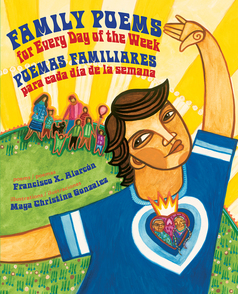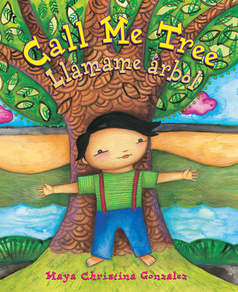 Released last fall from the Children’s Book Press imprint of LEE & LOW BOOKS, Family Poems for Every Day of the Week/Poemas familiares para cada día de la semana is a celebratory collection of poems that highlights the daily life of children every day of the week while also honoring the experiences of Latino poet Francisco X. Alarcón, who passed away in January 2016. We interviewed illustrator Maya Christina Gonzalez about the important role that family and friends play in Family Poems for Every Day of the Week and what the creative process was like: Continue reading
Released last fall from the Children’s Book Press imprint of LEE & LOW BOOKS, Family Poems for Every Day of the Week/Poemas familiares para cada día de la semana is a celebratory collection of poems that highlights the daily life of children every day of the week while also honoring the experiences of Latino poet Francisco X. Alarcón, who passed away in January 2016. We interviewed illustrator Maya Christina Gonzalez about the important role that family and friends play in Family Poems for Every Day of the Week and what the creative process was like: Continue reading
Tag Archives: maya christina gonzalez
Poetry Friday: Animal Poems of the Iguazú/Animalario del Iguazú
April is National Poetry Month! All month long we’ll be celebrating by posting some of our favorite poems for Poetry Friday. To celebrate Earth Day, for today’s Poetry Friday, we chose a poem from Animal Poems of the Iguazú/Animalario del Iguazú, written by Francisco X. Alarcón and illustrated by Maya Christina Gonzalez. Continue reading
WHY CREATE A GENDER NEUTRAL PICURE BOOK? A Guest Post from Maya Gonzalez
In this post, award-winning author and illustrator Maya Gonzalez shares why the picture book Call Me Tree / Llámame árbol is completely gender neutral.
You may or may not notice something different about my book, Call Me Tree. Nowhere in the story are boy/girl pronouns used. No ‘he’ or ‘she’ anywhere! I found it easy to write this way because that’s how I think of kids, as kids, not boy kids or girl kids.
I even requested that no ‘he’ or ‘she’ be used anywhere else in the book, like on the end pages or the back cover when talking about the story. I also asked the publisher to only refer to the main character as a child or kid when they talked about my book out in the world. Because I wanted Call Me Tree to be gender free!
Continue readingUsing Dual Language and Bilingual Books in First and Second Grade
![]() Jill Eisenberg is our Resident Literacy Expert. Jill began her career teaching English as a Foreign Language to second through sixth graders in Taiwan as a Fulbright Fellow. She went on to become a literacy teacher for third grade in San Jose, CA as a Teach for America corps member. She is certified in Project Glad instruction to promote English language acquisition and academic achievement. In her column she offers teaching and literacy tips for educators.
Jill Eisenberg is our Resident Literacy Expert. Jill began her career teaching English as a Foreign Language to second through sixth graders in Taiwan as a Fulbright Fellow. She went on to become a literacy teacher for third grade in San Jose, CA as a Teach for America corps member. She is certified in Project Glad instruction to promote English language acquisition and academic achievement. In her column she offers teaching and literacy tips for educators.
Note: This lesson can be done with other books, but dual language/bilingual books offer a unique opportunity to engage non-English speaking parents in the classroom and provide a way to continue rigorous discussions with their children at home regardless of English in the home. Bilingual books additionally underscore the diversity of our classroom communities and equalize parents as teachers in students’ minds.
Last week, I spoke about my experience teaching in a school where nearly 85% of my students were English Language Learners and English was not the primary language spoken at home. Using a bilingual book with a Spanish-speaking parent in the classroom is a strategy I learned teaching in San Jose, CA as a part of a parent engagement program called “Los Dichos de la Casa” by Silicon Valley YMCA.
Whether your classroom has only a few English Language Learners (ELLs) or a majority, bilingual and dual language books can encourage close reading of a text and increase accessibility of the text to ELLs. Over the next few posts, we will model how bilingual and dual language books are being used in classrooms to foster deep, critical thinking and a love of reading.


